Patent medicine
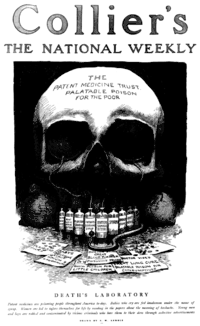
A patent medicine, also known as a nostrum (from the Latin nostrum remedium, or "our remedy") is a commercial product advertised (usually heavily) as a purported over-the-counter medicine, without regard to its effectiveness.
Patent medicines were one of the first major product categories that the advertising industry promoted; patent medicine promoters pioneered many advertising and sales techniques that were later used for other products.[1] Patent medicine advertising often marketed products as being medical panaceas (or at least a treatment for a large number of diseases) and emphasized exotic ingredients and endorsements from purported experts or celebrities, which may or may have not been true. Patent medicines were increasingly constricted in the United States in the early 20th century as the Food and Drug Administration and Federal Trade Commission added ever-increasing regulations to prevent fraud, unintentional poisoning and deceptive advertising. Sellers of liniments, claimed to contain snake oil and falsely promoted as a cure-all, made the snake oil salesman a lasting symbol for a charlatan.
Patent medicines and advertising
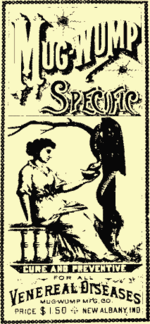
The phrase "patent medicine" comes from the late 17th century[2] marketing of medical elixirs, when those who found favour with royalty were issued letters patent authorising the use of the royal endorsement in advertising. Few if any of the nostrums were actually patented; chemical patents did not come into use in the United States until 1925. Furthermore, patenting one of these remedies would have meant publicly disclosing its ingredients, which most promoters sought to avoid.
Advertisement kept these patent medications in the public eye and gave the belief that no disease was beyond the cure of patent medication. “The medicine man’s key task quickly became not production but sales, the job of persuading ailing citizens to buy his particular brand from among the hundreds offered. Whether unscrupulous or self-deluded, nostrum makers set about this task with cleverness and zeal.”[3]
Instead, the compounders of such nostrums used a primitive version of branding to distinguish their products from the crowd of their competitors. Many extant brands from the era live on today in brands such as Luden's cough drops, Lydia E. Pinkham's vegetable compound for women, Fletcher's Castoria and even Angostura bitters, which was once marketed as a stomachic. Though sold at high prices, many of these products were made from cheap ingredients. Their composition was well known within the pharmacy trade, and druggists manufactured and sold (for a slightly lower price) medicines of almost identical composition. To protect profits, the branded medicine advertisements emphasized brand names, and urged the public to "accept no substitutes".
At least in the earliest days, the history of patent medicines is coextensive with scientific medicine. Empirical medicine, and the beginning of the application of the scientific method to medicine, began to yield a few orthodoxly acceptable herbal and mineral drugs for the physician's arsenal. These few remedies, on the other hand, were inadequate to cover the bewildering variety of diseases and symptoms. Beyond these patches of evidence-based application, people used other methods, such as occultism; the "doctrine of signatures" – essentially, the application of sympathetic magic to pharmacology – held that nature had hidden clues to medically effective drugs in their resemblances to the human body and its parts. This led medical men to hope, at least, that, say, walnut shells might be good for skull fractures. Given the state of the pharmacopoeia, and patients' demands for something to take, physicians began making "blunderbuss" concoctions of various drugs, proven and unproven. These concoctions were the ancestors of the several nostrums.
Touting these nostrums was one of the first major projects of the advertising industry. The marketing of nostrums under implausible claims has a long history. In Henry Fielding's Tom Jones (1749), allusion is made to the sale of medical compounds claimed to be universal panaceas:
- As to Squire Western, he was seldom out of the sick-room, unless when he was engaged either in the field or over his bottle. Nay, he would sometimes retire hither to take his beer, and it was not without difficulty that he was prevented from forcing Jones to take his beer too: for no quack ever held his nostrum to be a more general panacea than he did this; which, he said, had more virtue in it than was in all the physic in an apothecary's shop.

Within the English-speaking world, patent medicines are as old as journalism. "Anderson's Pills" were first made in England in the 1630s; the recipe was allegedly learned in Venice by a Scot who claimed to be physician to King Charles I. Daffy's Elixir was invented about 1647 and remained popular in Britain and the USA until the late 19th century. The use of "letters patent" to obtain exclusive marketing rights to certain labelled formulas and their marketing fueled the circulation of early newspapers. The use of invented names began early. In 1726 a patent was also granted to the makers of "Dr. Bateman's Pectoral Drops"; at least on the documents that survive, there was no Dr. Bateman. This was the enterprise of a Benjamin Okell and a group of promoters who owned a warehouse and a print shop to promote the product.
A number of American institutions owe their existence to the patent medicine industry, most notably a number of the older almanacs, which were originally given away as promotional items by patent medicine manufacturers. Perhaps the most successful industry that grew up out of the business of patent medicine advertisements, though, was founded by William H. Gannett in Maine in 1866. There were few circulating newspapers in Maine in that era, so Gannett founded a periodical, Comfort, whose chief purpose was to propose the merits of Oxien, a nostrum made from the fruit of the baobab tree, to the rural folks of Maine. Gannett's newspaper became the first publication of Guy Gannett Communications, which eventually owned four Maine dailies and several television stations. (The family-owned firm is unrelated to the Gannett Corporation that publishes USA Today.) An early pioneer in the use of advertising to promote patent medicine was New York businessman Benjamin Brandreth, whose "Vegetable Universal Pill" eventually became one of the best-selling patent medicines in the United States.[4] “…A congressional committee in 1849 reported that Brandreth was the nation’s largest proprietary advertiser… Between 1862 and 1863 Brandreth’s average annual gross income surpassed $600,000…”[5] For fifty years Brandreth’s name was a household word in the United States[6] Indeed, the Brandreth pills were so well known they received mention in Herman Melville's classic novel Moby Dick.[7]

Another publicity method – undertaken mostly by smaller firms – was the medicine show, a traveling circus of sorts that offered vaudeville-style entertainments on a small scale, and climaxed in a pitch for some sort of cure-all nostrum. "Muscle man" acts were especially popular on these tours, for this enabled the salesman to tout the physical vigour the product supposedly offered. The showmen frequently employed shills, who stepped forward from the crowd to offer "unsolicited" testimonials about the benefits of the medicine. Often, the nostrum was manufactured and bottled in the wagon in which the show travelled. The Kickapoo Indian Medicine Company became one of the largest and most successful medicine show operators. Their shows had an American Indian or Wild West theme, and employed many American Indians as spokespeople. The "medicine show" lived on in American folklore and Western movies long after they vanished from public life.
Ingredients and their uses

Supposed ingredients
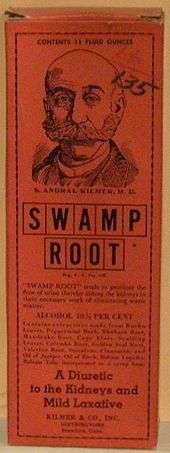
Some level of exoticism and mystery in the contents of the preparation was deemed desirable by their promoters. Unlikely ingredients such as the baobab fruit in Oxien were a recurring theme. A famous patent medicine of the period was Dr. Kilmer's Swamp Root; unspecified roots found in swamps had remarkable effects on the kidneys, according to its literature.
Native American themes were also useful: natives, imagined to be noble savages, were thought to be in tune with nature, and heirs to a body of traditional lore about herbal remedies and natural cures. One example of this approach from the period was Kickapoo Indian Sagwa, a product of the Kickapoo Indian Medicine Company of Connecticut (completely unrelated to the real Kickapoo Indian tribe of Oklahoma), supposedly based on a Native American recipe. This nostrum was the inspiration for Al Capp's "Kickapoo Joy Juice," featured in the comic strip, "Li'l Abner". Another benefit of claiming traditional native origins was that it was nearly impossible to disprove. A good example of this is the story behind Dr. Morse's Indian Root Pills, which was the mainstay of the Comstock patent medicine business. According to text on a wrapper on every box of pills, Dr. Morse was a trained medical doctor who enriched his education by travelling extensively throughout Asia, Africa, and Europe. He supposedly lived among the American Indians for three years, during which time he discovered the healing properties of various plants and roots that he eventually combined into Dr. Morse's Indian Root Pills. No one knows if Dr. Morse ever actually existed.
Other promoters took an opposite tack from timeless herbal wisdom. Nearly any scientific discovery or exotic locale could inspire a key ingredient or principle in a patent medicine. Consumers were invited to invoke the power of electromagnetism to heal their ailments. In the nineteenth century, electricity and radio were gee-whiz scientific advances that found their way into patent medicine advertising, especially after Luigi Galvani showed that electricity influenced the muscles. Devices meant to electrify the body were sold; nostrums were compounded that purported to attract electrical energy or make the body more conductive. "Violet ray machines" were sold as rejuvenation devices, and balding men could seek solace in an "electric fez" purported to regrow hair. Albert Abrams was a well known practitioner of electrical quackery, claiming the ability to diagnose and treat diseases over long distances by radio. In 1913 the quack John R. Brinkley, calling himself an "Electro Medic Doctor," began injecting men with colored water as a virility cure, claiming it was "electric medicine from Germany." (Brinkley would go on to even greater infamy through transplanting goat testicles into men's scrotums as a virility treatment.)
Towards the end of the period, a number of radioactive medicines, containing uranium or radium, were marketed. Some of these actually contained the ingredients promised, and there were a number of tragedies among their devotees. Most notoriously, steel heir Eben McBurney Byers was a supporter of the popular radium water Radithor, developed by the medical con artist William J. A. Bailey. Byers contracted fatal radium poisoning and had to have his jaw removed in an unsuccessful attempt to save him from bone cancer after drinking nearly 1400 bottles of Bailey's "radium water." Water irradiators were sold that promised to infuse water placed within them with radon, which was thought to be healthy at the time.
Actual ingredients
Contrary to what is often believed, some patent medicines did, in fact, deliver the promised results, albeit with very dangerous ingredients. For example, medicines advertised as "infant soothers" contained opium, then a legal drug. Those advertised as "catarrh snuff" contained cocaine, also legal. While various herbs, touted or alluded to, were talked up in the advertising, their actual effects often came from procaine extracts or grain alcohol. Those containing opiates were at least effective in relieving pain, coughs, and diarrhea, though they could result in addiction. This hazard was sufficiently well known that many were advertised as causing none of the harmful effects of opium (though many of those so advertised actually did contain opium).
Until the twentieth century, alcohol was the most controversial ingredient, for it was widely recognised that the "medicines" could continue to be sold for their alleged curative properties even in prohibition states and counties. Many of the medicines were in fact liqueurs of various sorts, flavoured with herbs said to have medicinal properties. Some examples include:
- Cannabis indica, the low growing variants of cannabis with a high level of THC.
- Peruna was a famous "Prohibition tonic," weighing in at around 18% grain alcohol. A nostrum known as "Jamaican ginger" was ordered to change its formula by Prohibition officials. To fool a chemical test some vendors added a toxic chemical, tricresyl phosphate, an organophosphate compound that produced organophosphate-induced delayed neuropathy, a chronic nerve damage syndrome similar to that caused by certain nerve agents. Unwary imbibers suffered a form of paralysis that came to be known as jake-leg.
- Clark Stanley, the "Rattlesnake King", produced Stanley's snake oil, publicly processing rattlesnakes at the World's Columbian Exposition in Chicago. His liniment, when seized and tested by the federal government in 1917, was found to contain mineral oil, 1% fatty oil, red pepper, turpentine and camphor. This is not too unlike modern capsaicin and camphor liniments.
- The original formulation of Coca-Cola used coca leaves, an indirect source of cocaine, and was marketed as an energy rejuvenator. Unlike most patent medicines of its era, it did not contain alcohol.
- Some herbal preparations included laxatives such as senna or diuretics, to give the compounds some obvious physical effects. Narcotics and stimulants at least had the virtue of making the people who took them feel better.
When journalists and physicians began focusing on the narcotic contents of the patent medicines, some of their makers began replacing the opium tincture laudanum with acetanilide, a particularly toxic non-steroidal anti-inflammatory drug with analgesic as well as antipyretic properties that had been introduced into medical practice under the name Antifebrin by A. Cahn and P. Hepp in 1886.[8] But this ingredient change probably killed more of the nostrum's users than the original narcotics did, since acetanilide not only caused an alarming cyanosis due to methemoglobinemia but was later discovered to cause liver and kidney damage.[9]
The occasional reports of acetanilide-induced cyanosis prompted the search for supposedly less toxic aniline derivatives, such as phenacetin.[10] After several conflicting results over the ensuing fifty years, it was ultimately established in 1948 that acetanilide was mostly metabolized to paracetamol (known in the United States as USAN: acetaminophen) in the human body, and that it was this metabolite that was responsible for its analgesic and antipyretic properties.[9][11][12][13] Acetanilide is no longer used as a drug in its own right, although the success of its metabolite – paracetamol (acetaminophen) – is well known.
Supposed uses

Patent medicines were supposedly able to cure just about everything. Nostrums were openly sold that claimed to cure or prevent venereal diseases, tuberculosis, and cancer. Bonnore's Electro Magnetic Bathing Fluid claimed to cure cholera, neuralgia, epilepsy, scarlet fever, necrosis, mercurial eruptions, paralysis, hip diseases, chronic abscesses, and "female complaints". William Radam's Microbe Killer, a product sold widely on both sides of the Atlantic in the 1890s and early 1900s, had the bold claim 'Cures All Diseases' prominently embossed on the front of the bottle. Ebeneezer Sibly ('Dr Sibly') in late 18th and early 19th century Britain went so far as to advertise that his Solar Tincture was able to "restore life in the event of sudden death", amongst other marvels.
Every manufacturer published long lists of testimonials that described their product curing all sorts of human ailments. Fortunately for both makers and users, the illnesses they claimed were cured were almost invariably self-diagnosed – and the claims of the writers to have been healed of cancer or tuberculosis by the nostrum should be considered in this light.
The end of the patent medicine era
Muckraker journalists and other investigators began to publicize instances of death, drug addiction, and other hazards from the compounds. This took some small courage on behalf of the publishing industry that circulated these claims, since the typical newspaper of the period relied heavily on the patent medicines. In 1905, Samuel Hopkins Adams published an exposé entitled "The Great American Fraud" in Collier's Weekly that led to the passage of the first Pure Food and Drug Act in 1906.[14] This statute did not ban the alcohol, narcotics, and stimulants in the medicines; it required them to be labeled as such, and curbed some of the more misleading, overstated, or fraudulent claims that appeared on the labels. In 1936 the statute was revised to ban them, and the United States entered a long period of ever more drastic reductions in the medications available unmediated by physicians and prescriptions. Morris Fishbein, editor of the Journal of the American Medical Association, who was active in the first half of the 20th century, based much of his career on exposing quacks and driving them out of business.
The patent medicine makers moved from selling nostrums to selling deodorants and toothpastes, which continued to be advertised using the same techniques that had proven themselves selling nostrums for tuberculosis and "female complaints." One survival of the herbal exoticism that once characterized the patent medicine industry is the marketing of shampoos, which are often promoted as containing perfumes such as vetiver or ylang-ylang, and foods such as mangoes, bananas, or honey; consumers are urged to put these ingredients in their hair despite lack of any evidence that these ingredients do anything other than make the hair smell like the ingredients.
In more recent years, also, various herbal concoctions have been marketed as "nutritional supplements". While their advertisements are careful not to cross the line into making explicit medical claims, and often bear a disclaimer that asserts that the products have not been tested and are not intended to diagnose or treat any disease, they are nevertheless marketed as remedies of various sorts. Weight loss "while you sleep" and similar claims are frequently found on these compounds (cf., Calorad, Relacore, etc.). One of the most notorious such elixirs, however, calls itself "Enzyte", widely advertised for "natural male enhancement" – that is, penis enlargement. Despite being a compound of herbs, minerals, and vitamins, Enzyte formerly promoted itself under a fake scientific name Suffragium asotas. Enzyte's makers translate this phrase as "better sex," but it is in fact ungrammatical Latin for "refuge for the dissipated".[15]
Surviving consumer products from the patent medicine era
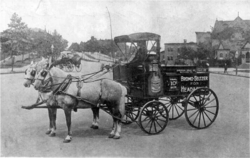
A number of brands of consumer products that date from the patent medicine era are still on the market and available today. Their ingredients may have changed from the original formulas; the claims made for the benefits they offer have typically been seriously revised. These brands include:
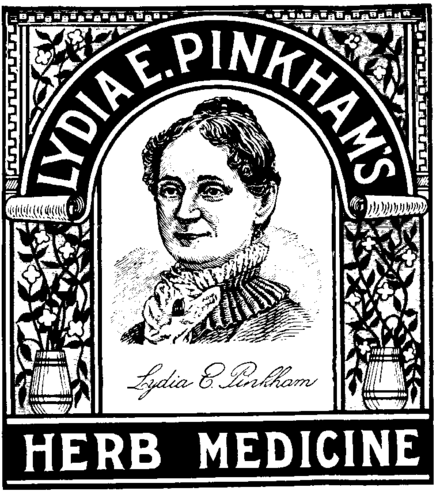
- Absorbine Jr.
- Anacin/Anadin
- Andrews Liver Salts
- Aspro aspirin tablets
- Bayer Aspirin
- BC Powder
- Bromo-Seltzer
- Carter's Little Liver Pills (Currently sold as Carter's Little Pills)
- Chlorodyne
- Doan's Pills
- Fletcher's Castoria
- Goody's Powder
- Lobeila Cough Syrup
- Lorman’s Indian Oil
- Luden's Throat Drops
- Lydia E. Pinkham's Vegetable Compound
- Minard's Liniment
- Phillips' Milk of Magnesia
- Smith Brothers Throat Drops
- Vicks VapoRub
A number of patent medicines are produced in China. Among the best known of these is Shou Wu Chih, a black, alcoholic liquid that the makers claimed turned gray hair black.
Products no longer sold under medicinal claims
Some consumer products were once marketed as patent medicines, but have been repurposed and are no longer sold for medicinal purposes. Their original ingredients may have been changed to remove drugs, as was done with Coca-Cola. The compound may also simply be used in a different capacity, as in the case of Angostura Bitters, now associated chiefly with cocktails.
- 7-Up
- Angostura Bitters
- Bovril
- Buckfast Tonic Wine
- Coca-Cola
- Dr Pepper
- Fernet Branca
- Graham crackers
- Grape-Nuts
- Hires Root Beer
- Moxie brand soda
- Pepsi Cola
- Tonic water
See also
- List of topics characterized as pseudoscience
- Bile Beans
- Blue mass (not a patent medicine, but a popular contemporary remedy)
- Chinese patent medicine
- Dr. Morse's Indian Root Pills
- Dr. Williams' Pink Pills for Pale People
- Drug fraud and Pharmaceutical fraud
- George Gill Green and his "Green's August Flower" and "Boschee's German Syrup"
- Godbold's Vegetable Balsam, popular late 18th century nostrum
- Hadacol
- Hamlin's Wizard Oil
- Homeopathy
- Mrs. Moffat's Shoo-Fly Powders for Drunkenness
- Opodeldoc
- Projector (patent)
- Quackery
- Revalenta arabica, 18th century nostrum
- Snake oil
- Swaim's Panacea, a popular and widely advertised 19th century American nostrum
- Tono-Bungay
- Universal panacea
- Warburg's Tincture, a 19th-century antipyretic drug sold as a secret remedy (not strictly a patent medicine, in the derogatory sense, but considered by some in its day as being one)
Footnotes
- ↑ See Conroy (2009), passim. for an account of E. Virgil Neal, patent medicine manufacturer and promoter (e.g. the tonic, nuxated iron, which was supposedly used by Ty Cobb, Jack Dempsey, and Pope Benedict XV), Madison Avenue pioneer, and mentor of Carl R. Byoir.
- ↑ "Balm of America: Patent Medicine Collection > History". National Museum of American History. Smithsonian Institution. Retrieved 20 September 2016.
- ↑ Young, James Harvey. 1961. The Toadstool Millionaires; a social history of patent medicines in America before Federal regulation. Princeton, N.J.: Princeton University Press. p. 166
- ↑ Atwater, Edward (2004). An Annotated Catalogue of the Edward C. Atwater Collection of American. New York: Boydell & Brewer. p. 117. ISBN 1-58046-098-4.
- ↑ Atwater, Edward (2004). An Annotated Catalogue of the Edward C. Atwater Collection of American. New York: Boydell & Brewer. p. 118. ISBN 1-58046-098-4.
- ↑ White, James Terry (1895). The National Cyclopaedia of American Biography. United States: J.T. White. p. 166. ISBN 0-403-01271-6.
- ↑ Melville, Herman (1892). Moby-Dick; Or, The White Whale. Boston: L.C. Page & Company. p. 386. ISBN 1-58729-906-2.
- ↑ Cahn, A.; Hepp, P. (1886), "Das Antifebrin, ein neues Fiebermittel", Centralbl. Klin. Med., 7: 561–64.
- 1 2 Brodie, B. B.; Axelrod, J. (1948), "The estimation of acetanilide and its metabolic products, aniline, N-acetyl p-aminophenol and p-aminophenol (free and total conjugated) in biological fluids and tissues", J. Pharmacol. Exp. Ther., 94 (1): 22–28, PMID 18885610.
- ↑ Bertolini, A.; Ferrari, A.; Ottani, A.; Guerzoni, S.; Tacchi, R.; Leone, S. (2006), "Paracetamol: new vistas of an old drug", CNS Drug Reviews, 12 (3–4): 250–75, PMID 17227290, doi:10.1111/j.1527-3458.2006.00250.x.
- ↑ Lester, D.; Greenberg, L. A. (1947), "Metabolic fate of acetanilide and other aniline derivatives. II. Major metabolites of acetanilide in the blood", J. Pharmacol. Exp. Ther., 90 (1): 68, PMID 20241897.
- ↑ Brodie, B. B.; Axelrod, J. (1948), "The fate of acetanilide in man" (PDF), J. Pharmacol. Exp. Ther., 94 (1): 29–38, PMID 18885611
- ↑ Flinn, Frederick B.; Brodie, Bernard B. (1948), "The effect on the pain threshold of N-acetyl p-aminophenol, a product derived in the body from acetanilide", J. Pharmacol. Exp. Ther., 94 (1): 76–77, PMID 18885618.
- ↑ Adams, Samuel Hopkins (1905). The Great American Fraud (4th ed., 1907). Chicago: American Medical Association. Retrieved 2009-07-30.
- ↑ "Why is this man smiling? It's not Viagra". USA Today. 2002-04-17. Retrieved 2010-05-21.
Further reading
- Conroy, M.S. (2009). The Cosmetics Baron You've Never Heard Of: E. Virgil Neal and Tokalon, Englewood: Altus History LLC. ISBN 0-615-27278-9
- American Medical Association, Council On Pharmacy and Chemistry (1908). The Propaganda For Reform In Proprietary Medicines (5th edition). Chicago: American Medical Association Press. Retrieved 2009-08-23.
- American Medical Association (1912). Nostrums and Quackery: Articles On The Nostrum Evil and Quackery Reprinted, With Additions and Modifications From The Journal Of The American Medical Association Reprinted (2nd ed.). Chicago: American Medical Association Press. Retrieved 2009-08-23.
- American Medical Association (1915). Medical Mail-Order Frauds. Chicago: American Medical Association Press. Retrieved 2009-08-23.
- Armstrong, David and Elizabeth M. (1991). The Great American Medicine Show, New York: Prentice-Hall. ISBN 0-13-364027-2
- Crabtre, Addison Darre (1880). The Funny Side Of Physic: Or, Mysteries Of Medicine, Presenting The Humorous And Serious Sides of Medical Practice. An Expose of Medical Humbugs, Quacks, And Charlatans In All Ages And All Countries. Chapter III. Patent Medicines. Hartford: The J. B. Burr Publishing Co. pp. 78–98. Retrieved 2009-08-23.
- Holbrook, Stewart A. (1959). The Golden Age of Quackery, Boston: MacMillan & Co.
- Oleson, Charles W. (1889). Secret Nostrums And Systems Of Medicine: A Book of Formulas (7th edition, 1896). Chicago: Oleson & Co., Publishers. Retrieved 2009-08-23.
- Pierce, R. V. (1917). The People's Common Sense Medical Adviser, eighty-third edition. World's Dispensary, available from Project Gutenberg
- The Proprietary Association (1908). Facts Worth Knowing: Falsehoods Exposed, The Truth About Patent Medicines,Mercenary And Selfish Character of Attack On Popular Household Remedies by Yellow Journals And Doctors' Organizations. The Proprietary Association. Retrieved 2009-08-23.
- Shaw, Robert B. (1972). History of the Comstock Patent Medicine Business and Dr. Morse's Indian Root Pills. Washington: Smithsonian Institution Press
- "Balm of America: Patent Medicine Collection," National Museum of American History
- Young, James Harvey (1961). The Toadstool Millionaires; a social history of patent medicines in America before Federal regulation. Princeton, N.J.: Princeton University Press
External links
| Wikimedia Commons has media related to Patent medicine. |
- Dr. Bob's Homepage for Medical Quackery
- Here Today, Here Tomorrow: Varieties of Medical Ephemera at the National Library of Medicine
- The Great American Fraud online exhibit at Vanderbilt Medical Library. Contains an etext of two of the Samuel Hopkins Adams exposés.
- The Toadstool Millionaires by James Harvey Young (1961), reproduced at Quackwatch by permission of Princeton University Press
- History of the Comstock Patent Medicine Business and Dr. Morse's Indian Root Pills by Robert B. Shaw
- Barak Orbach's Quack and Patent Medicine Collection
- Patent Medicine from Dr. J. C. Ayer & Co Photographs of products from the J. C. Ayer Company
- Patent Medicine Cards, a gallery of 247 patent medicine advertising cards, at UCLA library

